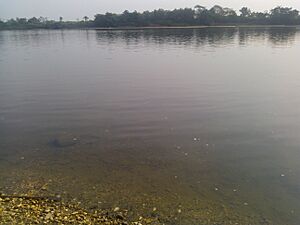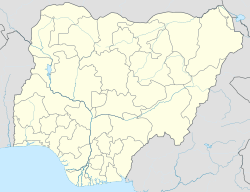Ikom facts for kids
Quick facts for kids
Ikom
|
|
|---|---|
|
LGA and town
|
|

The Cross River
|
|
| Country | |
| State | Cross River State |
| Area | |
| • Total | 1,961 km2 (757 sq mi) |
| Population
(2016 census)
|
|
| • Total | 79,103 |
| Time zone | UTC+1 (WAT) |
| 3-digit postal code prefix |
551
|
| ISO 3166 code | NG.CR.IK |
Ikom is a town and a Local Government Area in Cross River State, Nigeria. It is located in the southern part of Nigeria, near the Cross River. The town of Ikom is the main center of the area.
The Ikom Local Government Area covers about 1,961 square kilometers. In 2006, its population was around 162,383 people. Most people in Ikom are farmers. They grow a lot of cocoa, bananas, and plantains for sale across Nigeria.
Ikom is famous for its ancient stone carvings called the Ikom monoliths. These carvings have old writings on them, which some people think might be an early form of nsibidi writing. The postal code for the area is 551.
Ikom Local Government is part of the Central Senatorial District in Cross River State. It has 11 different council wards:
- Abanyum
- Yala-Nkum
- Olulumo
- Ofutop I
- Ofutop II
- Nta/Nselle
- Nde
- Abijinkpor
- Ikom Urban
- Akparabong
- Nnam
The history of Ikom as a local government area goes back to the 16th century. Back then, it was much larger and included parts of what are now Boki, Obubra, Abi, and Etung local government areas. In those early times, Ikom was led by Chief Priests or Village Heads. These leaders had both religious and community roles.
Modern Ikom became part of the Afikpo Division in the early 1950s. Then, in 1976, Ikom Local Government was officially created, with Ikom town as its main office. Ikom is bordered by Ogoja to the north and Boki to the northeast. To the east, it shares a border with Etung Local Government, and to the south, with Obubra Local Government Area.
The main languages spoken by the people of Ikom include Ofutop Bakor, Yala, Mbembe, and Ejagham. Many Ikom people are believed to have come from the Bantu group. Their main jobs are farming, trading, and cutting down trees (lumbering).
Contents
Culture and Traditions in Ikom
Historically, the slave trade caused big changes in Ikom. It led to different communities becoming separate and having to look after themselves. However, one thing that connects all the people in Ikom is their deep respect for traditional ways. This includes their beliefs in spirits, special dances, festivals, and folk stories.
Ikom's Economy and Opportunities
Exploring Tourism in Ikom
Ikom has many interesting places to visit. You can still see old buildings from early European traders. These traders did business along the Cross River in places like Okangha, Abaragba, Okundi, and Ikom town. Their old homes and offices are still standing.
The Ikom Town Beach is another great spot for visitors. It is about four kilometers from the Ikom local government headquarters. This sandy beach is a perfect place for people to relax and have fun.
Another amazing tourist attraction is the Alok and Nkarasi areas. Here, you can find carved stone monoliths. These special stones are also found in Nta-Nsellei Akaju, Abanyou, and Nde. They are made from basalt or limestone. The Nta and Nselle people call these carved stones "Akwanshi," which means "dead person on ground." Others call them "atal," meaning "the stones." These old carvings are found in groups, often in circles, and show human figures. An annual festival is held in these areas at the end of every dry season.
Investment and Business Potential
Ikom is a major producer of cocoa, much like the famous groundnut pyramids in Kano. There is a huge "cocoa pyramid" in Ikom that shows how much cocoa is grown here. Ikom is known for producing high-quality cocoa in Nigeria. The Cross River State Ministry of Agriculture reports that Ikom has over 1,917 hectares of cocoa farms. Currently, there isn't a factory in Ikom to process all this cocoa. This means there's a big chance for businesses to set up cocoa processing plants.
Ikom also has many forest resources, like different types of trees. These include mahogany, iroko, and teak. There is a lot of wood available for use, but not many large-scale logging activities happen yet. This creates an opportunity for investors to build wood-based furniture factories. These factories could turn raw wood into finished products for local use or for export. The forests of Ikom are also home to many animals, such as monkeys, leopards, and bush pigs.
Minerals and Natural Resources
Besides farming, Ikom has valuable mineral deposits. Salt brine deposits are found in Akparabong. These could be used for large-scale salt production. Baryte, another mineral, is also found in large amounts in Ekukunela (Ofutop). These minerals are currently not being fully used.
Growing Food for the Nation
Ikom has rich soil that is perfect for growing many crops. It produces excellent plantains and bananas. Large amounts of yam, maize, and coco-yam are also grown here. These food products are often sent to other parts of Nigeria, including the northern states, Calabar, and other eastern states.
In March 2021, a significant event happened for Ikom. About 7,000 metric tonnes of cocoa beans were shipped from the Calabar seaport to the United States. All of these cocoa beans came from Ikom. This was a big step forward for Cross River State's export business.
Climate in Ikom
Ikom has a tropical climate. This means it has a short dry season and a long wet season. This type of climate is known as Aw or Am in the Köppen climate classification.
| Climate data for Ikom (1991–2020) | |||||||||||||
|---|---|---|---|---|---|---|---|---|---|---|---|---|---|
| Month | Jan | Feb | Mar | Apr | May | Jun | Jul | Aug | Sep | Oct | Nov | Dec | Year |
| Record high °C (°F) | 38.6 (101.5) |
39.6 (103.3) |
39 (102) |
38.4 (101.1) |
36.9 (98.4) |
34.2 (93.6) |
34 (93) |
32.9 (91.2) |
39 (102) |
39.5 (103.1) |
37.2 (99.0) |
36.2 (97.2) |
39.6 (103.3) |
| Mean daily maximum °C (°F) | 33.2 (91.8) |
35.0 (95.0) |
34.8 (94.6) |
33.4 (92.1) |
32.5 (90.5) |
30.9 (87.6) |
29.6 (85.3) |
29.0 (84.2) |
30.3 (86.5) |
31.3 (88.3) |
32.3 (90.1) |
32.6 (90.7) |
32.1 (89.8) |
| Daily mean °C (°F) | 26.8 (80.2) |
28.7 (83.7) |
29.2 (84.6) |
28.4 (83.1) |
27.7 (81.9) |
26.7 (80.1) |
26.1 (79.0) |
25.7 (78.3) |
26.4 (79.5) |
26.9 (80.4) |
27.4 (81.3) |
26.6 (79.9) |
27.2 (81.0) |
| Mean daily minimum °C (°F) | 20.4 (68.7) |
22.4 (72.3) |
23.7 (74.7) |
23.4 (74.1) |
23.0 (73.4) |
22.8 (73.0) |
22.7 (72.9) |
22.6 (72.7) |
22.5 (72.5) |
22.5 (72.5) |
22.2 (72.0) |
20.5 (68.9) |
22.4 (72.3) |
| Record low °C (°F) | 13.7 (56.7) |
15 (59) |
18 (64) |
17 (63) |
17 (63) |
15 (59) |
17 (63) |
17 (63) |
15.4 (59.7) |
19 (66) |
14.3 (57.7) |
14.5 (58.1) |
13.7 (56.7) |
| Average precipitation mm (inches) | 10.0 (0.39) |
37.9 (1.49) |
86.0 (3.39) |
168.1 (6.62) |
262.8 (10.35) |
361.4 (14.23) |
328.2 (12.92) |
326.5 (12.85) |
351.5 (13.84) |
326.9 (12.87) |
65.2 (2.57) |
6.6 (0.26) |
2,331.1 (91.78) |
| Average precipitation days (≥ 1.0 mm) | 1.0 | 2.5 | 6.0 | 10.7 | 15.6 | 19.3 | 19.6 | 20.2 | 20.7 | 19.2 | 4.7 | 0.6 | 140.2 |
| Average relative humidity (%) | 73.1 | 76.0 | 83.2 | 86.7 | 88.7 | 90.0 | 90.4 | 90.3 | 90.7 | 90.6 | 85.9 | 76.3 | 85.2 |
| Source: NOAA | |||||||||||||
More to Explore
- Ikom monoliths
- Agbokim waterfalls


